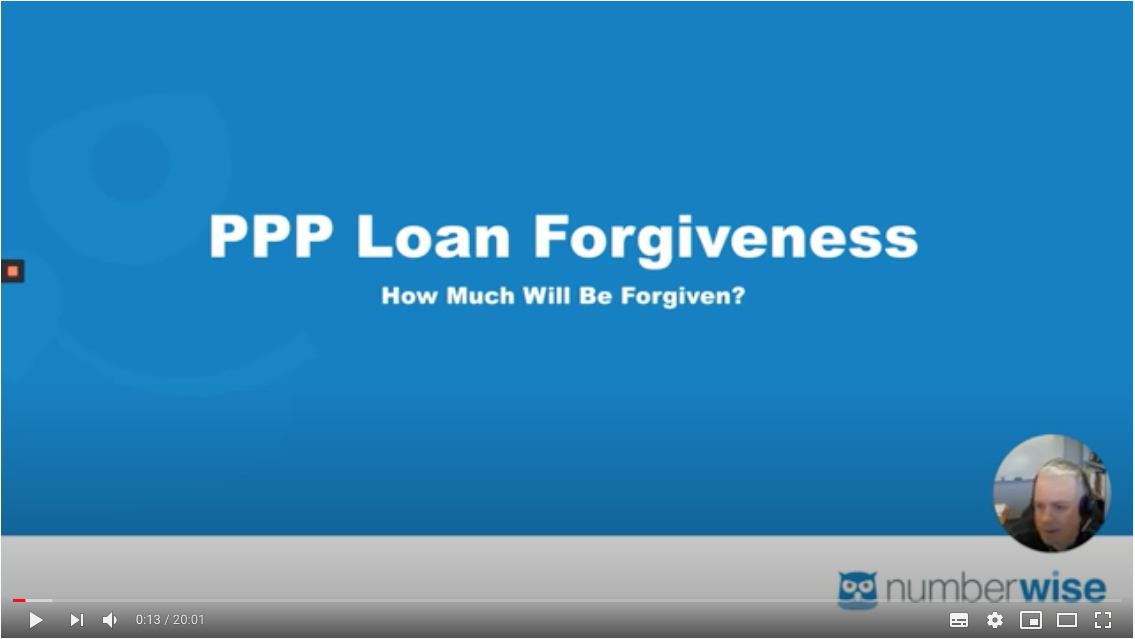Are you trying to determine how much of your Paycheck Protection Program loan can be forgiven? In this video Andy, the owner of Numberwise Accounting, walks through the details of the PPP loan forgiveness, example calculations, and factors that may impact your loan forgiveness.
Highlights from Video
The Basics (what you can use the money for)
Starting at :47 in video
Loan proceeds can be used for:
- Payroll Costs: Wages, state & local payroll taxes, health insurance, retirement benefits
- Self-employment income of a partners is a “payroll cost”
- Rent or mortgage interest
- Utilities (electricity, gas, water, transportation*, telephone, internet)
*The “transportation” aspect is the least clear, so we recommend omitting it from your calculation until further guidance is released.
The Calculation (potential loan forgiveness)
Starting at 3:28 in video
- Start with “Payroll Costs”
- Add other qualified expenses (limited to 25% of total)
- Compare to loan amount
- Potential forgiveness is smaller of the two numbers
Examples
Scenario #1
Loan amount: $100,000
Payroll costs: $80,000
Other expenses: $20,000
Potential loan forgiveness: $100,000
Scenario #2
Loan amount: $100,000
Payroll costs: $45,000
Other expenses: $20,000 (limited to $15,000 that can be forgiven… 25% of total)
Potential loan forgiveness: $60,000
Scenario #3
Loan amount: $100,000
Payroll costs: $80,000
Other expenses: $25,000
Potential loan forgiveness: $100,000
Reduction in Forgiveness
Starting at 7:00 in video
Potential forgiveness will be reduced if you:
- Reduce your number of employees based on Full Time Equivalents (FTEs)
- Reduce any employees wages by more than 25%
Note: there is some language in the act stating that if you return back to normal by June 30th you may still have it forgiven, but there is ambiguity around this.
Reduction in Employees
Starting at 9:00 in video
Please note: the PPP loan forgiveness application (released after this video was recorded) uses a 40 hour week to calculate an FTE. If someone works 40 hours/week, they count as a full-time employee. Two part-time people that each work 20 hrs/week count as one FTE.
Calculate your FTE employees for both of these periods:
- February 15, 2019 – June 30, 2019
- January 1, 2020 – February 29, 2020
You can use the lower of the two numbers on the FTE calculations you did. Compare that number to the 8-week period starting when you receive the funds.
Reduction in Wages
Starting at 13:12 in video
Reducing employee wages may also impact your loan forgiveness, but this part is the least clear. If you reduce an employee’s wages by more than 25% it can impact your loan forgiveness. However, how this will be calculated and various scenarios have not been explained. We will update this post when additional guidance is available.
What Should I Do?
Starting at 14:15 in video
- Keep (or re-hire) employees who can be productive
- Calculate your potential “other expenses” to come up with an ideal payroll amount
- Don’t forget about payroll taxes – this cost is not forgivable as part of the PPP loan, so this is an expense to consider
- Know your required FTE number for full forgiveness
- Follow the latest developments
- Keep good records – the better your bookkeeping, the easier it will be to produce the documents you will need to provide to your lender to receive loan forgiveness
For more details on your loan, see our Paycheck Protection Program Loan Guide FAQ blog post.
Check out our COVID-19 resource page for more blog posts, videos and helpful information for businesses during the Coronavirus pandemic.









